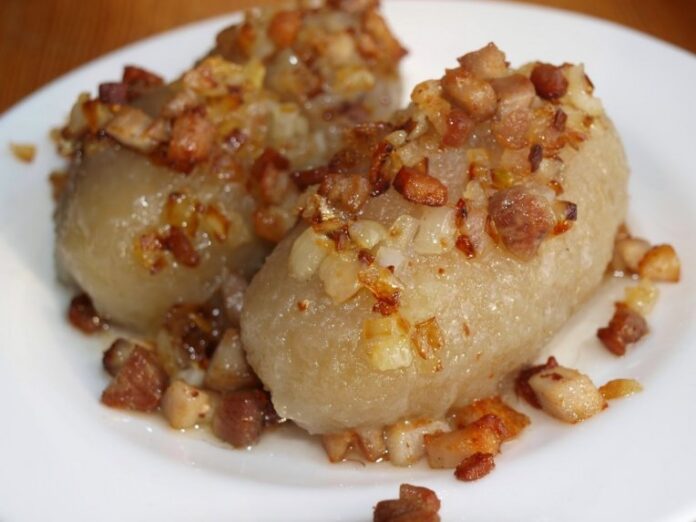
Anyone who knows a Lithuanian probably knows about cepelinai. Although cepelinai are arguably the most recognizable staple of Lithuanian cuisine, ethnologists say they are a fairly recent invention and were established in Lithuanian cuisine only after the Second World War.
They are called cepelinai after the inventor of the zeppelin, because their traditional shape reminds us of the dirigible. Linguists tell us that the true Lithuanian word for them is didžkukuliai (giant dumplings), because they are – big. And that’s what they’re called in restaurants in Lithuania.
It is also believed that cepelinai have German origins and are based on Kartoffelknödel. There are many versions of the dish, and similar dumplings can be found in countries such as Denmark, Norway, Ukraine, and Belarus. However, cepelinai remain most popular in Lithuania and the northeastern part of Poland. In Lithuania, they first appeared in the Samogitia (Žemaitija) region, where they came from the German-Lithuanian minority. Later, they became a popular dish in other parts of the country.
Apparently there is little variation in how cepelinai are prepared in different Lithuanian regions. Potato dishes are more common in the regions that used to be close to Prussia, such as Sūduva, Žemaitija, and Lithuania Minor. In Aukštaitija (in northeastern Lithuania), potato pancakes were more common than cepelinai.
The new World Cepelinai Day “holiday” (only a holiday if you’re not the one making this dish) has been celebrated since February 2014, with Lithuanians around the world making and devouring this hearty and dearly loved potato dish. Its day of celebration was reportedly invented by the Lithuanian-American community. Across the US, the Superbowl, the game that decides that year’s American football champions, draws people together for large viewing parties, traditionally with masses of chicken wings and other popular party foods. For one such event, Juozas Vaičiūnas, a member of the Lithuanian-American community in Detroit, decided cepelinai would be the perfect food, given their similarity to footballs. Since then, the holiday has become international, and coincides with the Superbowl, which is usually held on the first (this year the second) Sunday in February.
“Cepelinai Day is every day“ in Lithuania, and many aficionados would agree. If only they were easier to make. Peeling the potatoes is one thing, but the grating is another story. If you have a special Lithuanian grating machine, it can be simple. There are stories of people hauling those machines back from Europe, using juicers, or grating then chopping the Lithuanian national vegetable to a specific consistency in a food processor. The trick is to squeeze out the right amount of moisture from the processed potatoes, then mix them very well with half as many boiled mashed potatoes for a fluffier result.
Cooks tell us that the most important thing is the quality of the potatoes, and the use of starchier potato varieties. A Lithuanian restaurant in Cleveland, Ohio, is reported to offer six different kinds of cepelinai – stuffed with pork, farmer’s (cottage) cheese, mushrooms, a beef, onion and bacon stuffing, salmon, and cepelinai with corned beef, sauerkraut and cheese modelled on the popular Reuben sandwich. The sky’s the limit, it seems, as long as the ingredients are encased in potatoes.
They are traditionally served with sour cream, fried bacon bits with chopped onions (our dear “spirgučiai”), dill or butter. This recipe, concocted from three secret sources, is a good place to start. It is impossible to specify the number of potatoes or the number of cepelinai the recipe produces, because the size of the potatoes and the size of the cepelinai you make will vary.
Ingredients:
10 raw Russet potatoes, peeled (about 6 pounds)
5 boiled potatoes (about 3 pounds), peeled and mashed
1 egg
1 tsp salt
1 tsp black pepper
1 lb ground meat (usually pork, or a combination of pork and beef)
1 chopped onion, sautéed
2-3 tbsp potato starch (from package)
Method:
Boil the smaller amount of potatoes. Grate the raw potatoes, then strain their liquid into a bowl. Let it rest for 10 minutes so the starch will settle. Peel and mash the boiled potatoes (best to use a ricer of food mill). The mashed potatoes should be completely cooled, otherwise the starch will not bind the mixture. Add salt and mix very well with the raw processed potatoes. Pour off the potato water and add 2 to 3 tablespoons of the starch, or if there is not enough settled starch from the liquid, use the packaged variety.
Mix the meat, chopped sautéed onion, 1 egg, salt and pepper. Take a handful of potato mixture and form into a patty. Put a tablespoon or two of meat in the centre and wrap the patty around it, shaping it with wet hands and smoothing the surface into a small zeppelin (or football). Note: The larger the dumpling, the more likely it is to fall apart while boiling.
Boil well-salted water in a large pot, adding 1 tbsp. potato starch (mixed with cold water, if packaged). Keep the water at a boil as each dumpling is added, but lower the heat to simmer once they are all in and they rise to the surface.
Serve with sour cream and bacon bits.
Note: For zeppelins with cheese, use about a pound of farmer’s cheese (cottage cheese), 1 tsp. marjoram, 1 egg, 1 tsp. sugar and 1 tsp. salt for 4-5 pounds of potatoes.
Good luck! Laimingai!





























